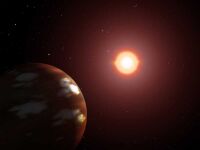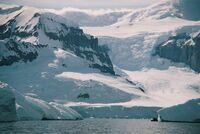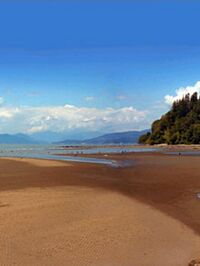Efros

Efros is a bitterly cold storm-crossed class M world. The planet is just exitting an Ice Age, and as a result, the sea levels are once again rising and there are broad expanses of tropical areas once again reforming around the planet's equator.
Planetary Data[edit]

- World Name: Efros
- System Name: Flarset
- Number of Class M planets: 1
- Position in system: IV
- Number Of Satellites: 0
- Planetary Gravity: 1.1G
- Diameter: 14,300 km
- Equatorial Circumference: 45,000 km
- Total Surface Area: 642,400,000 sq. km
- Percentage Land Mass: 36%
- Total Land Mass: 231,000,000 sq. km
Planetary Conditions[edit]
- Length Of Day: 29 hrs
- Atmospheric Density: Terrestrial
- General Climate: Arctic
Mineral Content[edit]
Normal Metals: 46% Radioactives: 17% Gemstones: 13% Industrial Crystals: 8% Special Minerals: 2%
Planetary Description[edit]

The name Efros means Ice in the Efrosian tongue. The planet is a cold, harsh world that only in the last thousand years emerged from a millenia-long ice age. Few native animals live on Efros, as the climate makes it extremely difficult for plants to thrive. However, the abundance of metal on the planet makes it valuable nonetheless. The planet is only barely Class M. The first survey, in fact, identified it as a Class L world. The Evironment is slowly changing as a result of the rrecession of the massive ice sheets that have wrapped the planet in a major ice age. Additionally, the Starfleet Corps of Engineers are using some terraforming technologies to help speed the planet's recovery.
Climate:[edit]
Efrosian frost-fields[edit]
Efrosian frost-fields are features of the planet Efros. These are massive broad open plains covered with ice flows. Only a few hardy plants such as the Efrosian Orchid are capable of surviving in this harsh environment. The frost fields and similar terrain and environmental conditions account for nearly 80% of the planets biosphere.

The ice sheets are beginning to recede and as the planet warms, they sea levels are rising. This has seen an explosion in verdant plant growth which is beginning to take full advantage of the newer warmer equatorial environment. Nice sandy beaches and balmy weather is common at the equator. however, the rapid climate changes spawn violent and unpredictable storms, which have been know to completely devestate massive swaths of land. The Starfleet Corps of Engineers are performing Surveys to determine if Weather Modification Satellites could be implemented to assist in dissipating the most violent storms as they form.